Case 1
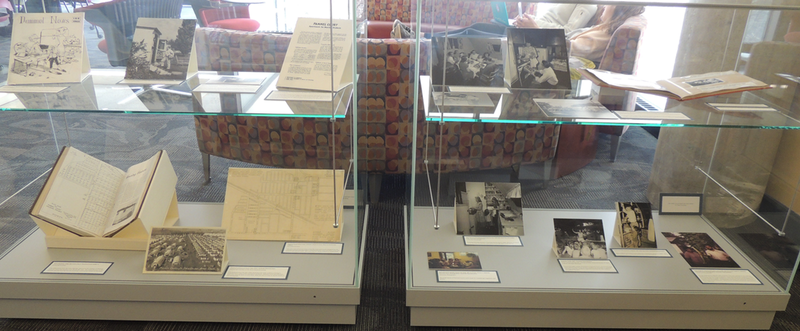
For Married Students: Building a Community in Pammel Court 1946-1978
The history of Pammel Court is a story of community and place. Originally founded after World War Two to provide temporary housing for returning veterans and their families, Pammel Court's collection of surplus metal units and narrow streets became a significant part of the Iowa State landscape for over fifty years. During its existence, Pammel Court was known by many names, including “boomtown,” “the silver city,” “fertile acres,” “the city within a city,” and even the “slums” of Iowa State. Few places on campus have evoked such strong feelings and memories.
From 1946 to 1978, Pammel Court was reserved for married students and their children. This exhibit is their story. It is about the creation of a housing development, the building of a community, and the lasting memories of place.
Images in the case (which is two short cases in the physical exhibit):
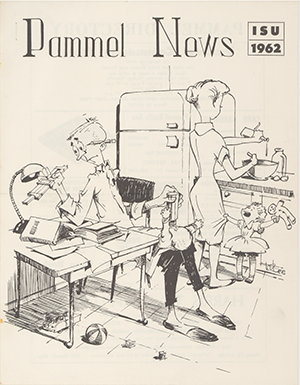
Pammel Court News, 1962. (RS 7/4/3, box 3, “Pammel Court" folder). Department of Residence Buildings Records.
This cartoon from 1962 illustrates the challenges Pammel Court’s residents faced in their daily lives. Life in Pammel Court often meant juggling being a spouse, a parent, and a student.
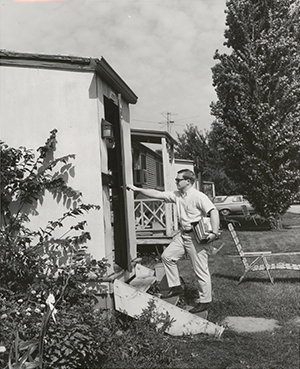
Student at the Front Door, 1965. (RS 7/4/I, box 489). University Photographs.
This photograph shows Fred Merrifield, an Iowa State student, entering his unit in the mid-1960s.

Street View of Pammel Court Residence, circa 1978. (RS 21/7/222). Janet A. Jepeway Pammel Court Photographs.
When Pammel Court first opened in 1946 the housing project consisted of a mixture of trailers, prefabricated houses, Quonset Huts, and barracks buildings. By the 1970s, only the corrugated metal barracks buildings were left. Residents in Pammel Court were often free to personalize their rental units. This included painting the exterior and interior of the units, and planting gardens in the small yard space each residence afforded.
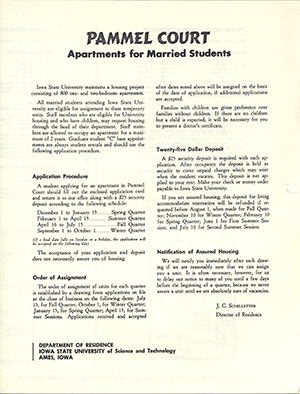
Pammel Court for Married Students, undated. (RS 7/4/12, box 11, folder 17). Julian C. Schilletter Papers.
Married students looking for campus housing received brochures such as this, outlining floorplans and rental prices for Pammel Court. During Pammel Court’s existence from 1946 to the late 1990s, housing units would often be replaced, but the low rental rates were a constant. From 1946 to the early 1960s, military service veterans were given priority to Pammel Court’s housing. With veterans utilizing funds through the G.I. Bill, saving on costs was a concern. Not surprisingly, Pammel Court proved a popular housing choice, despite the small living quarters it offered.
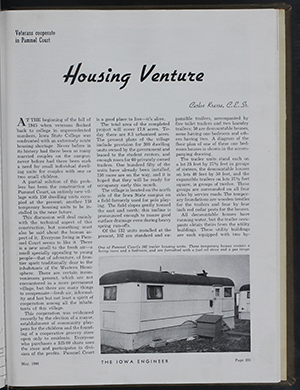
Iowa Engineer, 1946. (RS 7/4/3, box 3, “Pammel Court" folder). Department of Residence Buildings Records.
This 1946 article from the Iowa Engineer reports on the creation of Pammel Court for returning veterans from World War Two. The article focuses on the need for married housing and also examines construction details of the units.
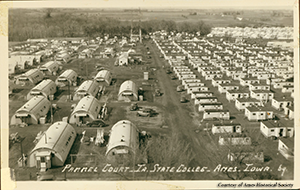
Postcard of Pammel Court, circa 1947. Photograph courtesy of the Ames Historical Society. All Rights Reserved.
This photograph from the late 1940's illustrates the close confines of living in Pammel Court when it first opened to residents. Pammel Court was placed in field once used for polo at Iowa State. Note the lack of trees or paved streets in the photograph.

Thanksgiving Day, 1948. (RS 7/4/H, box 473). University Photographs.

Thanksgiving dinner at Pammel Court, 1948. (RS 7/4/H, box 473). University Photographs.

Cooking Thanksgiving dinner in cramped quarters. (RS 7/4/H, box 473). University Photographs.
Thanksgiving Day, 1948. (RS 7/4/H, box 473). University Photographs.
These three images speak to the sense of community that existed among Pammel Court’s residents. For holidays that occurred during a school session, it was not uncommon for two or more families to gather together for a potluck meal, even if it meant dining in cramped quarters.
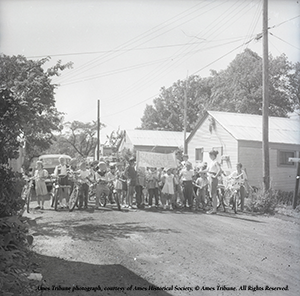
Pammel Court Bicycle Parade, circa 1957. Ames Tribune Photograph, Courtesy of Ames Historical Society, © Ames Tribune. All Rights Reserved.
From the very beginning, children were a large part of daily life in Pammel Court. Images such as this help illustrate the local effects of the national “baby boom” in the two decades after World War Two.
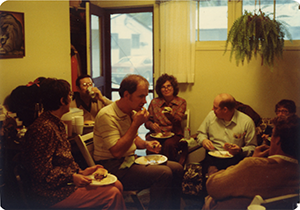
Pammel Court Interior Scene, undated. (RS 21/7/222). Janet A. Jepeway Pammel Court Photographs.
The small spaces of Pammel Court's units made for crowded get-togethers and parties.

Two Women and Child on Thanksgiving Day, 1948. (RS 7/4/H, box 473). University Photographs.
A young child helps prepare a Thanksgiving Day meal in 1948. Note the curvature of the Quonset Hut and the maximization of storage space in the kitchen.

Summer Camp, 1957. Ames Tribune photograph, courtesy of Ames Historical Society, © Ames Tribune. All Rights Reserved.
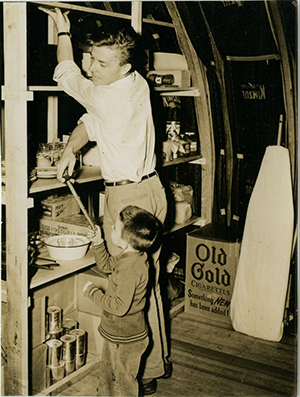
Pammel Court Grocery, undated. (RS 7/4/H, box 473). University Photographs.
Early residents of Pammel Court organized a cooperative grocery in 1946. The first location was in a Quonset Hut as seen in this photograph.
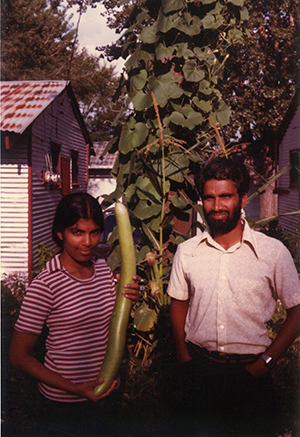
Two Students at Pammel Court, circa 1978. (RS 21/7/222). Janet A. Jepeway Pammel Court Photographs.
For the 1978-1979 academic year, Pammel Court was opened to non-married students for the first time in its history. From Pammel Court’s creation in 1946 to its being open for single students in 1978, low rental prices had always been popular among residents. Those living in Pammel Court sacrificed amenities to save money on monthly rent. Pammel Court units were cold in the winter and hot in the summer, but many former residents remember leaving Iowa State debt-free.